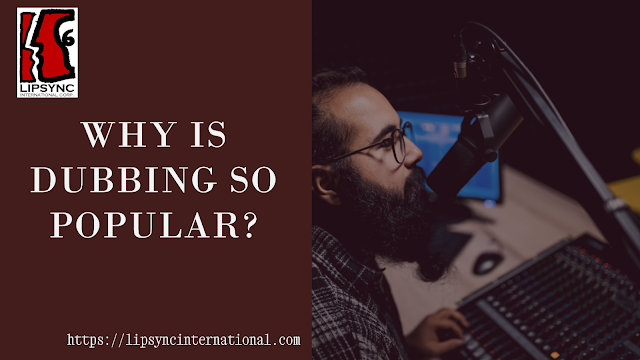Why is dubbing so popular?
Introduction
Dubbing has become an integral part of the entertainment industry, revolutionizing the way we experience global content. This article explores the factors contributing to the widespread popularity of dubbing, from its historical roots to its technological advancements.
The Rise of Dubbing
In the early days, language barriers limited the reach of films and TV shows. Dubbing emerged as a solution, breaking down linguistic barriers and making content accessible to diverse audiences.
The Art of Dubbing
Dubbing is not merely translation; it's an art form. Skilled voice actors bring characters to life, capturing emotions and nuances to deliver an authentic viewing experience.
Evolution of Dubbing Techniques
Advancements in technology have transformed dubbing techniques, enhancing lip-sync accuracy and seamlessly integrating voices into the original content.
Dubbing vs. Subtitling
While subtitling has its place, dubbing offers a more immersive experience. Viewers can focus on the visuals without the distraction of reading subtitles.
The Global Appeal of Dubbing
Dubbing transcends borders, allowing content creators to reach a global audience. It facilitates cultural exchange by sharing stories in different languages.
Dubbing in the Entertainment Industry
Beyond movies, dubbing has expanded its reach to TV series, animations, and even video games, contributing to the globalization of entertainment.
Dubbing in Cinema
Cinematic experiences are enriched through dubbing, enabling audiences worldwide to connect with diverse storytelling styles and cultural narratives.
Impact on Cultural Exchange
Dubbing fosters a deep understanding of various cultures, breaks down stereotypes, and promotes empathy through shared narratives.
Technology Advancements in Dubbing
Cutting-edge technology has elevated dubbing, enabling real-time adjustments and ensuring synchronization between voice and visuals.
Dubbing in the Digital Age
Digital platforms have fueled the demand for dubbed content, providing viewers with a vast array of choices across languages and genres.
Famous Dubbing Studios
Explore renowned dubbing studios that have played a pivotal role in shaping the global landscape of dubbed entertainment.
Dubbing Challenges and Solutions
Delve into the challenges faced by dubbing professionals and the innovative solutions that keep the industry moving forward.
How Dubbing Enhances Viewer Experience
Discover how dubbing contributes to a more immersive and enjoyable viewer experience, making content relatable and engaging.
The Role of Voice Actors in Dubbing
Behind every dubbed character is a talented voice actor. Learn about their crucial role in bringing stories to life in different languages.
Psychological Aspects of Dubbing
Examine the psychological impact of hearing familiar voices, exploring how dubbing creates emotional connections with characters.
Why is Dubbing Crucial for Global Content?
Understand the significance of dubbing in ensuring the global accessibility and acceptance of content across linguistic and cultural boundaries.
Dubbing in Different Genres
Explore how dubbing adapts to various genres, from drama to comedy, enhancing the universal appeal of storytelling.
Cultural Sensitivity in Dubbing
Address the importance of maintaining cultural sensitivity in dubbing, respecting nuances, and avoiding misinterpretations.
Future Trends in Dubbing
Look ahead to the future of dubbing, considering emerging technologies and evolving viewer preferences.
FAQs
How does dubbing enhance the viewing experience?
Dubbing adds an immersive layer to the viewing experience, allowing audiences to connect emotionally with characters in their native language.
Is dubbing more effective than subtitling?
Dubbing tends to be more effective as it eliminates the need for reading subtitles, enabling viewers to focus entirely on the visual content.
Can dubbing change the cultural context of a film?
While dubbing aims for cultural sensitivity, certain nuances may be lost. However, efforts are made to retain the essence of the original content.
What challenges do dubbing professionals face?
Dubbing professionals face challenges such as lip-sync accuracy, cultural nuances, and maintaining the integrity of the original performances.
How are voice actors selected for dubbing?
Voice actors are chosen based on their ability to convey the emotions and nuances of the original performances, ensuring a seamless dubbing experience.
Are there advancements in dubbing technology?
Yes, technology has significantly advanced in dubbing, with real-time adjustments and sophisticated tools enhancing the quality of dubbed content.
Conclusion
In conclusion, the popularity of dubbing is a testament to its ability to bridge cultural gaps and provide a universal language for storytelling. As technology continues to evolve, dubbing will play an increasingly crucial role in the global entertainment landscape.




Comments
Post a Comment